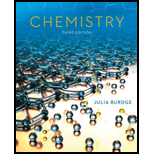
Interpretation:
The freezing point of the given glucose solution is to be calculated.
Concept introduction:
The osmotic pressure (π) of a solution is the product of the molarity, gas constant, and temperature. It is expressed as follows:
Here,
Molality is defined as the ratio of number of moles of the solute to the mass of the solvent (in kilograms). It is expressed as follows:
Here,
The temperature at which change of liquid state to solid state occurs is called freezing point.
The freezing point depression is as follows:
Here,
Density is defined as the ratio of mass to volume. It is expressed as follows:
Here,
Answer to Problem 126AP
Solution:
Explanation of Solution
Given information:
The osmotic pressure is
The density is
The gas constant R is
The osmotic pressure is expressed as follows:
Here,
Rearrange the above equation for the calculation of molarity as follows:
Substitute
The density of the solution is expressed as follows:
Rearrange the above equation for the calculation of mass as follows:
Consider the volume of the solution to be
The mass of
Number of moles is calculated as follows:
Rearrange the above equation for the calculation of mass of glucose as follows:
Substitute,
The mass of the solvent is the difference between the mass of the solution and the mass of the solute. It is calculated as follows:
Substitute,
The molality of the solution is calculated by the expression given below:
Substitute
The freezing point depression is calculated by using the expression given below:
Here,
Substituting the required values:
The freezing point of the glucose solution is
Want to see more full solutions like this?
Chapter 13 Solutions
Chemistry-Connect Plus Access
- Water at 25 C has a density of 0.997 g/cm3. Calculate the molality and molarity of pure water at this temperature.arrow_forwardCalculate the molality of a solution made by dissolving 115.0 g ethylene glycol, HOCH2CH2OH, in 500. mL water. The density of water at this temperature is 0.978 g/mL. Calculate the molarity of the solution.arrow_forwardWhat would be the freezing point of a solution formed by adding 1.0 mole of glucose (a molecular compound) to the following amounts of water? a. 250 g (0.25 kg) b. 500 g (0.500 kg) c. 1000 g (1.000 kg) d. 2000 g (2.000 kg)arrow_forward
 Chemistry: The Molecular ScienceChemistryISBN:9781285199047Author:John W. Moore, Conrad L. StanitskiPublisher:Cengage Learning
Chemistry: The Molecular ScienceChemistryISBN:9781285199047Author:John W. Moore, Conrad L. StanitskiPublisher:Cengage Learning General Chemistry - Standalone book (MindTap Cour...ChemistryISBN:9781305580343Author:Steven D. Gammon, Ebbing, Darrell Ebbing, Steven D., Darrell; Gammon, Darrell Ebbing; Steven D. Gammon, Darrell D.; Gammon, Ebbing; Steven D. Gammon; DarrellPublisher:Cengage Learning
General Chemistry - Standalone book (MindTap Cour...ChemistryISBN:9781305580343Author:Steven D. Gammon, Ebbing, Darrell Ebbing, Steven D., Darrell; Gammon, Darrell Ebbing; Steven D. Gammon, Darrell D.; Gammon, Ebbing; Steven D. Gammon; DarrellPublisher:Cengage Learning Chemistry: Principles and ReactionsChemistryISBN:9781305079373Author:William L. Masterton, Cecile N. HurleyPublisher:Cengage Learning
Chemistry: Principles and ReactionsChemistryISBN:9781305079373Author:William L. Masterton, Cecile N. HurleyPublisher:Cengage Learning Chemistry & Chemical ReactivityChemistryISBN:9781337399074Author:John C. Kotz, Paul M. Treichel, John Townsend, David TreichelPublisher:Cengage Learning
Chemistry & Chemical ReactivityChemistryISBN:9781337399074Author:John C. Kotz, Paul M. Treichel, John Townsend, David TreichelPublisher:Cengage Learning Chemistry & Chemical ReactivityChemistryISBN:9781133949640Author:John C. Kotz, Paul M. Treichel, John Townsend, David TreichelPublisher:Cengage Learning
Chemistry & Chemical ReactivityChemistryISBN:9781133949640Author:John C. Kotz, Paul M. Treichel, John Townsend, David TreichelPublisher:Cengage Learning





